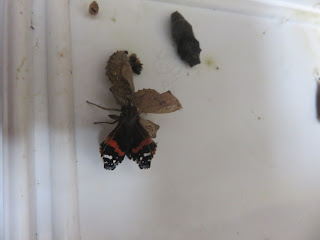The mysterious life of the Death’s-head Hawk-moth
Death’s-head Hawk-moth. Photo: Steve Andrews
The Death’s-head Hawk-moth (Acherontia atropos) is a very remarkable insect in many ways. Once seen it will never be forgotten with its skull-like marking on the back of its thorax, dark but beautifully patterned wings, its massive size, and stout furry banded body. But this hawkmoth must lead a very difficult life, and it doesn’t surprise me that it is rare. The Death’s-head Hawk-moth’s main food is apparently honey and it steals this from beehives. It is even known as the “Bee Robber.” So one of the first things the insect must do in its life is locate a hive, not so easy these days with the terrible decline in honeybees, said to be due to Colony Collapse Disorder. It then has to enter the home of the bees, find the honeycomb and use its short proboscis to break through the wax to steal the sweet liquid.
There are theories about how it manages to do this without being attacked by angry bees. One theory is that it emits a smell that causes the bees to leave it alone because it mimics the scent of the bees. It appears that the moth requires the stimulus of being in a hive to go about feeding. In captivity if supplied with honey on a pad it won’t touch this. Websites with details of caring for the moth say that the only way to feed it is to carefully hold the insect and unroll the proboscis so that it goes into a mixture of honey and water. Although the moths will struggle, it is said that after one or two attempts they will learn to feed this way and will take their food on future days. I cannot confirm this because I have to admit I have given up with my attempts and have released moths in my care. The Death’s-head Hawk-moth also squeaks quite loudly when alarmed, and it is definitely alarmed when held for attempted force feeding. My question is why won’t it feed itself? Otherwise in published literature there is very little information about how the adults feed. In a very few places I have read that they also take tree sap and resin, have been known to puncture fruit, accept rotting fruit, and even that they take the nectar from a Petunia flower, not the normal way but by breaking into the part of the flower that holds the nectar. I have left a moth with a pad soaked in honey and water, and also with Petunia flowers and the moth ignored all of it. Literature on these moths also maintain that this hawkmoth will not attempt to mate until the males have fed and until a few days have gone by. So even if you have males and females emerging around the same time it is still not easy to get them to mate. You have to find a way to feed them, and need somewhere to keep the insects safely where they do not damage their wings trying to escape. In my experience this moth emerges from its pupa at night and soon after the wings are dried it wants to fly. I have had them eclose in the early hours of the morning. I have read that the moth flies very late at night, and this appears to be correct. Researching the Death’s-head Hawk-moth fails to turn up much information that I haven’t given here. I am wondering whether these moths do feed otherwise but have not been studied well enough for anyone to know how they feed or what on.
Death’s-head Hawk-moth caterpillar. Photo: Steve Andrews
The caterpillars are another matter though, and the information on them today is far, far greater than when I was a boy. Books on insects many years ago used to say the caterpillar fed on the foliage of the Potato, possibly on the Jasmine too, and that was about it. Nowadays the reported range these huge larvae can eat is very wide indeed. Besides Potato and Jasmine, it is known to feed on Deadly Nightshade, Woody Nightshade, Snowberry, Thornapple, Tree Tobacco, Tomato, Hemp, Lantana, Olive, Privet, Lilac, Buddleia and Tulip Tree. I have found them on Thornapple in Tenerife and Lantana there. I suspect the caterpillar can also feed on Sea Grape because I encountered a wandering larva once in a shopping precinct where the only vegetation present was on some specimens of this tree. Unlike many species, the caterpillar of the Death’s-head Hawk-moth is almost spoiled for choice. Nevertheless I have found they don’t like to switch plants that they have been eating. Larvae reared on Privet expect more Privet. Besides the unusual feeding habits of the adult moths, I wonder what causes some of them to embark on lengthy migrations, including those in which it flies over the seas. This species has been found as far north as the Shetland Islands in the UK, but clearly could not withstand the winters up there, which would be far too cold. It is said that this species cannot get through winters in Britain elsewhere. What causes it to migrate? How does it decide which direction to fly? How does it find beehives? The Death’s-head Hawk-moth is a very mysterious moth don’t you agree?


























